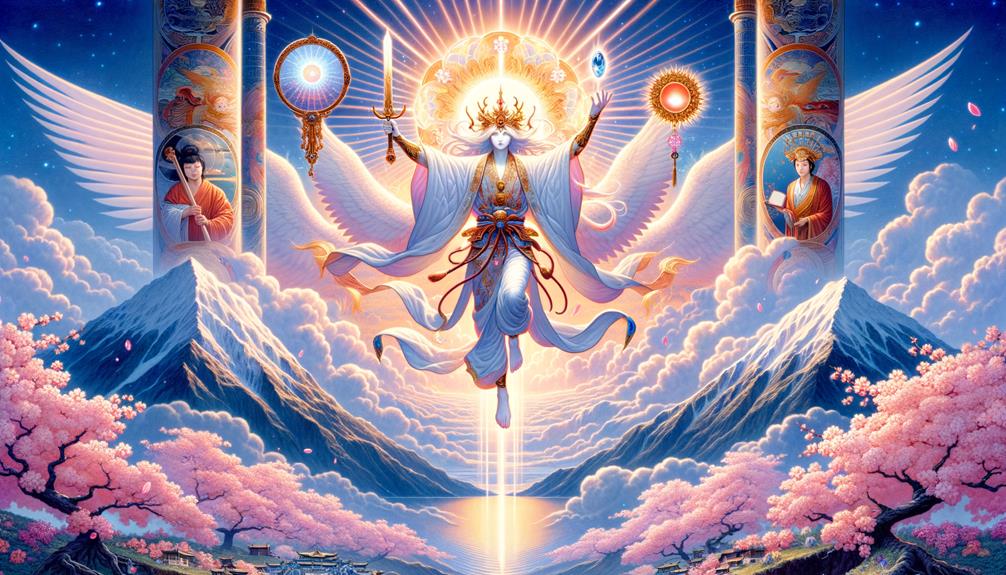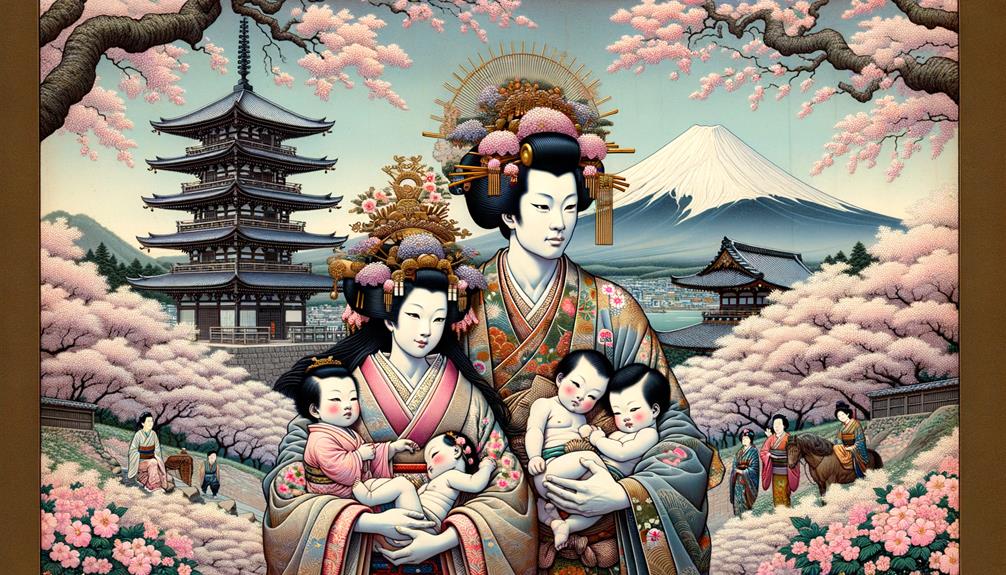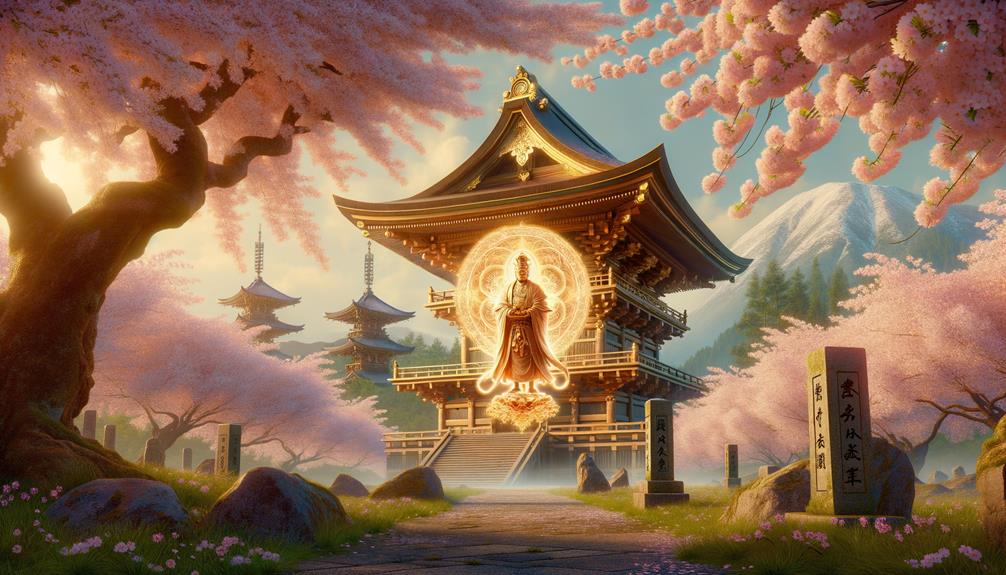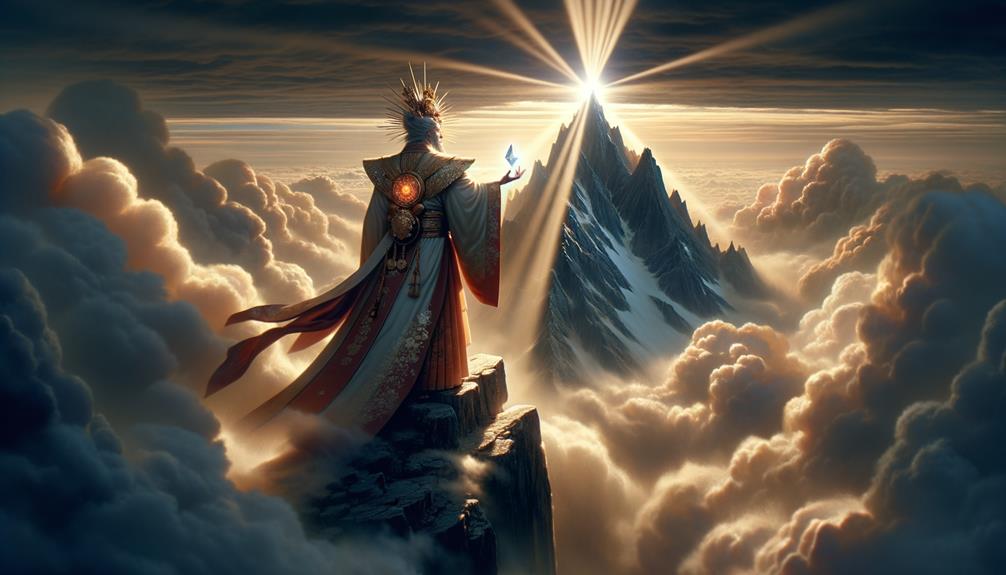When I look at Ninigi, grandson of Amaterasu, I see more than a mythological figure; I see an embodiment of heavenly authority and earthly stewardship. His descent represents the tangible connection between the celestial and the human realms, questioning the nature of power and its roots. His marriage to Konohanasakuya-hime and their offspring solidify this sacred lineage, infusing it with symbols of fertility and continuity. What intrigues me most, however, is how his story intertwines with the broader narrative of the Yamato dynasty's divine right to rule.
This tale resonates with contemporary discussions around leadership and legitimacy. Ninigi's celestial origins parallel modern narratives of leaders claiming a mandate from higher powers or principles. His marriage and offspring mirror the importance placed on legacy and dynastic succession in many societies. Yet, the story also invites scrutiny of such claims – questioning the true sources of authority and the line between myth and reality. In a world grappling with issues of power and accountability, revisiting ancient tales like Ninigi's offers valuable context and prompts reflection on enduring human concerns.
Etymology and Name
Exploring Ninigi-no-Mikoto's name unlocks a fascinating tapestry steeped in symbolism, underscoring his divine status in Japanese mythology. His name translates to "The Great God Ninigi," instantly elevating his standing. Another interpretation, "Ame-nigishi-kuni-nigishi-amatsuhiko-hiko-ho-no-ninigi-no-Mikoto," invokes imagery of a cherished jeweled mallet, reflecting his preciousness and craftsmanship among the deities.
Ninigi's lineage traces directly to Amaterasu, the revered sun goddess central to Japanese mythology. As her grandson, his name and celestial origins highlight the sacred bloodline binding him to the heavens. This connection not only amplifies his significance but legitimizes the Yamato clan's claim to divine ancestry. Guided by Amaterasu, Ninigi was entrusted with an earthly mission, solidifying his role as a heavenly intermediary.
His name, lineage, and celestial origins intertwine, crafting a profound narrative. Ninigi's name transcends a mere label, embodying his celestial heritage and the enduring legacy of Japan's imperial family.
Mythical Origins

Ninigi's mythical origins intertwine heavenly roots with an earthly mission. As Amaterasu's grandson, the revered sun goddess handpicked him to unite Japan under her divine decree. More than a journey, his descent marked a sacred calling to establish the Yamato clan's celestial legacy.
Japanese lore upholds Ninigi's pivotal role. Entrusted with a jewel, mirror, and sword – emblems of authority – he embodied the Imperial Family's divine right to rule. These regalia weren't mere artifacts; they represented sacred legitimacy rooted in Shinto beliefs.
Ninigi's marriage to Princess Konohana Sakuya-hime further cemented his earthly responsibilities, birthing sons who carried his divine lineage forward. This symbolic union melded celestial and terrestrial realms, a theme echoing throughout Japan's cultural tapestry and the Emperor's sacred stature.
Journey to Earth

When Ninigi descended onto Kyushu Island, it marked a pivotal moment – the coming together of celestial authority and earthly governance, paving the way for the Yamato dynasty's divine mandate to rule. Ninigi's journey exemplified the archetypal hero's path, where a divine mission and earthly leadership became intertwined.
Descent From Heaven
At the request of Amaterasu, Ninigi embarked on a sacred journey from the celestial realm to Earth, marking a momentous event that connected the divine and mortal worlds. This transition wasn't a mere physical relocation; it solidified the heavenly lineage of the Yamato clan, Japan's imperial family. When Ninigi stepped onto Kyushu Island, he didn't simply arrive at a new location; he initiated an era of harmony and progress for the entire nation.
Ninigi's journey carried the weight of a hallowed duty: to bring peace and civilization to Japan, guided by his celestial grandmother's blessings. His arrival on Earth held profound symbolic meaning, intertwining the heavens and the mortal realm in an eternal bond. This event stands as a cornerstone in Japanese mythology, cementing Ninigi as a crucial figure in the narrative of divine kingship and cultural heritage.
| Celestial Realm | Transition | Mortal World |
|---|---|---|
| Amaterasu's domain | Ninigi's journey | Kyushu Island |
| Divine mandate | Sacred mission | Establishing harmony |
| Heavenly lineage | Connecting worlds | Imperial legacy |
| Celestial blessing | Symbolic act | Cultural heritage |
This transition from the celestial realm symbolized not only the divine right of the Yamato clan but also the enduring link between Japan's spiritual and earthly existence.
Establishing Yamato Dynasty
Ninigi's arrival on Kyushu Island sparked the dawn of the Yamato Dynasty, tying divine authority to earthly governance. As Amaterasu's grandson, Ninigi brought the imperial bloodline from the celestial realm to the terrestrial domain. His journey transcended the physical, symbolically establishing the Yamato clan's heavenly origins and anchoring Japan's imperial lineage to the gods.
Under Amaterasu's guidance, Ninigi carried three sacred objects: a jewel, a mirror, and a sword. These items, known as the Imperial Regalia of Japan, weren't mere objects but powerful symbols representing benevolence, wisdom, truth, and valor – the foundations of Japanese cultural heritage and Shinto principles. Their enduring significance in imperial ceremonies highlights the Yamato dynasty's spiritual and cultural continuity.
Through Ninigi's divine mandate, the Yamato dynasty wasn't just established but enshrined, ensuring the divine lineage and symbols of authority would forever guide Japan's governance and identity.
Marriage and Children

In Japanese mythology, Ninigi's marriage to Princess Konohanasakuya-hime beautifully intertwines divine destiny with human loyalty. Their union, blessed by the Sun Goddess Amaterasu's celestial lineage, became a cornerstone tale. From this union, three sons emerged, each embodying distinct qualities and potential paths.
- Hoderi: His name evokes the sea and its abundant gifts, symbolizing fertility.
- Hoori: Known for his adventures, he personifies the archetypal hero on a quest for greatness.
- Hosuseri: His presence reflects the richness and diversity within divine ancestry.
- In some versions, Hikohohodemi is mentioned, adding layers to the myth's complexity.
Princess Konohanasakuya-hime's miraculous childbirth highlighted her unwavering devotion and divine favor bestowed upon their lineage. These children weren't mere offspring; they symbolized the continuation of a heavenly heritage, bridging realms. Each son played pivotal roles in subsequent folklore, weaving through the tapestry of Japanese myths. Their stories resonate as archetypal tales of struggle, triumph, and the quest to find one's place in the cosmos, mirroring the deeper human experience.
Symbols of Authority

Ninigi's divine mandate manifested through the sacred mirror, sword, and jewel he received – the Imperial Regalia of Japan. These weren't just objects but profound symbols of his celestial lineage and leadership responsibilities.
The mirror represented truth and purity, reflecting Amaterasu's divine wisdom and reminding Ninigi of his connection to the sun goddess. He was meant to embody her virtues. The sword symbolized his role as a guardian and warrior, representing the strength to lead with integrity. More than a weapon, it signified valor and protection. The jewel embodied prosperity and fertility Ninigi was entrusted to bestow upon his people – true benevolence.
These regalia reinforced the emperor's divine right to rule, tying the present to mythology. They legitimized Ninigi's celestial authority and Japan's continuity of tradition. Central to imperial ceremonies, the symbols made his divine mandate tangible.
Cultural Significance

Ninigi's mythological journey and the divine artifacts he received continue influencing contemporary ceremonies and shaping Japan's identity. His legacy bridges the mythic past with the present, reinforcing the imperial family's sacred connection to the gods – a potent symbol of ancestral lineage and divine right that resonates deeply in the national consciousness.
Symbol of Divine Right
Ninigi received the sacred mirror, sword, and jewel from Amaterasu as powerful symbols signifying his divine right to rule. These artifacts, collectively known as the Imperial Regalia of Japan, embody his celestial ancestry and deep cultural roots.
The sacred mirror reflects wisdom and enlightenment, tracing back to Amaterasu herself. It validates Ninigi's legitimate claim to power. The sword represents valor and the responsibility to protect his people, a divine duty bestowed upon him. The jewel symbolizes benevolence and prosperity, essential virtues for a ruler.
Together, the Imperial Regalia solidifies Ninigi's spiritual connection and rightful place as emperor. These meaningful symbols permeate Japanese traditions, forever linking the monarchy's past and present through an unbroken divine lineage.
Ancestral Lineage Importance
Ninigi's divine ancestry forms a pivotal foundation in Japanese mythology, directly tying the imperial family to the gods and emphasizing the cultural importance of preserving this celestial connection. As Amaterasu's grandson, Ninigi's role in establishing the Yamato clan is fundamental. His descent from the heavens symbolizes the sacred authority bestowed upon Japan's Imperial house, solidifying its hallowed status.
The guidance from Amaterasu, coupled with the sacred mirror, sword, and jewel, are not mere symbols but tangible manifestations of the divine right and responsibility held by Japan's Imperial family. These revered objects, central to ceremonies, preserve the imperial lineage's sanctity.
Ninigi's union with Sakuya-hime and his assertion of authority illustrate the melding of divine will with earthly governance. This marriage represents the archetype of divine leadership sanctioning, critical for Japan's first Emperor and successors.
Ninigi's ancestral lineage is more than mythological – it remains a cultural bedrock for Japan's Imperial tradition.
Mythological Influence Today
Even today, Japan continues to honor the mythological tale of Ninigi's descent from the heavens, deeply woven into the nation's identity. This age-old narrative highlights Ninigi's divine lineage, establishing the origins of Japan's imperial rule.
Contemporary Japanese society reflects the enduring legacy of this myth through:
- Imperial Regalia: The sacred mirror, sword, and jewel gifted to Ninigi by Amaterasu remain integral to imperial ceremonies.
- Shinto Traditions: Rituals and festivals pay homage to the divine connection, fostering harmony and peace.
- Imperial Lineage: The Japanese Emperor traces ancestry directly to Ninigi, reinforcing the perceived mandate to lead.
- Cultural Expression: Folklore, art, and literature continue celebrating the divine descent narrative.
Ninigi's mythical journey resonates across generations, shaping Japan's cultural fabric and imperial traditions. This tale of celestial origins remains deeply embedded in the nation's psyche.
Frequently Asked Questions
Which Objects Did the Sun Goddess Amaterasu Give Her Grandson?
Amaterasu gifted her grandson three sacred treasures: a sword representing valor, a mirror signifying purity, and a jewel embodying compassion. These relics profoundly connect to archetypal themes of divine authority and Japanese cultural heritage in mythology.
Who Is the Offspring of Amaterasu?
Amaterasu's offspring was Ame-no-Oshihomimi, a figure symbolizing celestial authority and the divine connection between heavenly realms and earthly imperial power in Japanese mythology. His birth highlights the recurring theme of divine lineage bridging the spiritual and worldly domains.
Who Is the Direct Descendant of Amaterasu?
Mythological interpretations often link Ninigi, Amaterasu's grandson, to Japan's imperial dynasty. His role bridges the heavenly realm's mandate with earthly rule. However, you could argue Ninigi merely personifies the transition from divine legend to documented history.
Did Amaterasu Marry Her Brother?
Amaterasu didn't wed her brother; she bore a son, symbolizing light emerging from a divine union. This myth explores enduring themes of sacred creation and sibling separation to uphold cosmic equilibrium.


